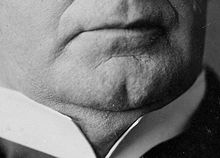chin
The lower front of the face in the area of the lower jaw , which is supported by the protuberantia mentalis and the lateral cusps ( tubercula mentalia ) of the lower jaw on both sides, is called the chin (lat. Mentum ) . Above it are the chin muscle ( mentalis muscle ), laterally the lower lip puller ( depressor labii inferioris muscle ) and above the lower portion of the oral sphincter ( orbicularis oris muscle ). These muscles are part of the facial muscles and are innervated by the facial nerve . Sensitive innervation is provided by the mental nerve , a branch of the inferior alveolar nerve . The blood supply is provided by the ramus mentalis of the arteria and vena alveolaris inferior . Below the chin, between the front bellies, lie the Mm. digastrici the chin lymph nodes ( Lymphonodi submentales ). The visible areas lateral to the chin are also known as the jaws .
The protruding chin is an acquisition of the recent human and probably serves as a reinforcement of the lower jaw on the border of the two jaw halves. In contrast to the (older) inwardly developed reinforcement of the connection in early humans and those animals that also need a more rigid connection of the lower jaw halves due to a freely movable jaw, this reinforcement is developed outward in modern humans, which gives the tongue more freedom of movement gives. The uniqueness of the chin is thus directly related to the uniqueness of modern man's ability to speak.
A fat apron under the actual chin is called a double chin, and this can also be surgically removed.
The chin as an attractive feature
Scientific studies show that women rate the appearance of men on the chin. Attractiveness requires a sharp angular chin and is associated with strength and a thirst for adventure.
A prominent chin can be hereditary and is determined by the hormone level in the mother's blood. However, the chin can also grow later: the growth of the chin is triggered by the androgen testosterone , the level of which can be increased naturally through exercise.

Individual evidence
- ↑ Duden: Kinnbacken, der
- ^ Wilhelm Wallisch: The chin and its purpose. In: Zeitschrift für Anatomie und Entwicklungsgeschichte , Volume 74, No. 1–3, 1924, pp. 285–296, doi: 10.1007 / BF02307401 .
- ↑ https://www.deutschlandfunknova.de/beitrag/attraktivit%C3%A4t-kantiges-kinn-gro%C3%9Fe-augen "Attractiveness angular chin, big eyes"
- ↑ https://www.news.de/gesundheit/855022614/maenner-auf-kinn-und-wangen-geprueft/1/
- ↑ https://www.blick.ch/life/wissen/menschen/vier-punkte-fuer-echte-kerle-ein-kantiger-typ-dank-mama-id4197753.html "Four points for real guys. An edgy guy thanks to mom. Masculinity is not in the genes, but in the mother's blood - testosterone makes bones grow. "

